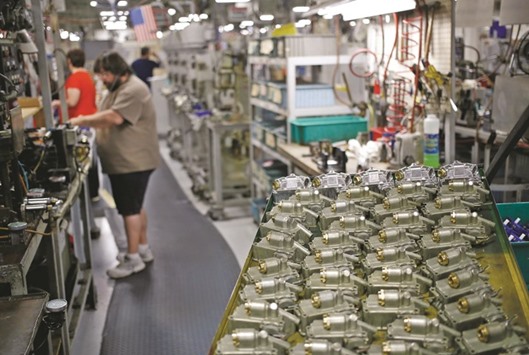Factory activity in the US Midwest surged to its highest in almost 1-1/2 years in June amid strong gains in new orders and production, offering a ray of hope for the downtrodden manufacturing sector.
While another report yesterday showed an increase in the number of Americans filing for unemployment benefits last week, layoffs remained low in June, backing views the labour market remained healthy despite last month’s paltry job gains.
The signs of stability in manufacturing and low layoffs added to consumer spending data in suggesting that economic growth regained speed in the second quarter.
But a cloud looms over the economy following Britain’s shock vote last week to leave the European Union.
The so-called Brexit referendum unsettled markets and yesterday, the International Monetary Fund said uncertainty over Britain’s departure was the biggest risk to the global economy.
“The unexpected Brexit decision could have material influence on how manufacturers view the near-term outlook.
It could also impact firms’ hiring decisions over the coming months,” said Sam Bullard, a senior economist at Wells Fargo Securities in Charlotte, North Carolina.
The Institute for Supply Management-Chicago said its business barometer jumped 7.5 points to 56.8 this month, the highest since January 2015.
The increase unwound the prior two months’ declines.
A gauge of new orders received by factories in the Midwest region surged to its highest since October 2014.
A measure of backlogged orders was the highest in more than five years, after contracting for 16 consecutive months.
At the same time, manufacturers reported that production was at a five-year high and inventories were growing again.
US stocks rose for a third straight day, in line with global markets.
The dollar was little changed against a basket of currencies, while prices for US government debt rose.
While the ISM-Chicago survey is volatile, it mirrored similar gains in some other regional factory surveys.
Both the New York and Philadelphia Federal Reserve Banks this month reported rebounds in factory activity in New York state and mid-Atlantic region respectively.
But their counterparts in Dallas and Richmond reported further slumps in activity.
The Institute for Supply Management is expected to report today that its national factory index was little changed at 51.4 in June.
A reading above 50 indicates expansion in the manufacturing sector, which accounts for about 12 % of the US economy.
Despite the improvement in sentiment surveys, data on factory orders, business spending and industrial production have shown manufacturing stuck in a rut since mid-2014 following a surge in the US dollar.
Manufacturing has also been undermined by lower oil prices which have put pressure on producers of energy-related equipment and efforts by businesses to reduce an inventory overhang have also inflicted pain.
In a separate report, the US Labour Department said initial claims for state unemployment benefits increased 10,000 to a seasonally adjusted 268,000 for the week ended June 25.
Claims have now been below 300,000, a threshold associated with a strong jobs market, for 69 consecutive weeks, the longest streak since 1973.
The four-week moving average of claims, considered a better measure of labour market trends as it irons out week-to-week volatility, was unchanged at 266,750 last week.
“The trend in the claims data has improved since late in May, supporting our view that the sharp weakening in May payrolls overstated any underlying softening in the labour market,” said Daniel Silver, an economist at JPMorgan in New York.
Nonfarm payrolls increased only 38,000, the smallest gain since September 2010.
A Reuters survey of economists forecast payrolls rising 180,000 in June.
The Labour Department will publish its June employment report on July 8.

Carburetor components are seen on an assembly line at the Holley Performance Products manufacturing facility in Bowling Green, Kentucky. The signs of stability in manufacturing and low layoffs added to consumer spending data yesterday in suggesting that economic growth regained speed in the second quarter.


